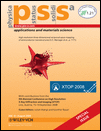Anomalous X-ray scattering study of the local structure in Ge-Se glasses
Abstract
Anomalous X-ray scattering experiments on glassy GexSe1−x semiconductors have been carried out at energies close to the Ge and Se K edges in a wide concentration range from x = 0.15 to 0.333 across the rigidity percolation threshold composition of x = 0.20. The total structure factors, S(Q), show considerable variation with x in both the position and intensity of the prepeak at about 10 nm−1, while in the remaining Q range, it stays almost unchanged. The differential structure factors, ΔiS(Q), comprise characteristic features, depending on the absorption edges. Comparing them suggests that the prepeak indicating the existence of intermediate-range order (IRO) purely originates from the Ge-Ge partial correlations. In contrast to the S(Q), the prepeak in ΔGeS(Q) changes very slightly with varying x down to x ∼ 0.20, suggesting that the prepeak height in SGeGe(Q) largely enhances with decrease in the Ge concentration, in particular at the the rigidity percolation threshold composition. However, a sudden decrease and a shift of the Q position are seen at the Ge concentration less than the stiffness transition composition, which may relate to the sudden decrease of the GeSe4–GeSe4 connections in the floppy region of this glassy system.




